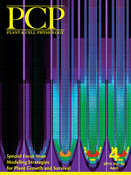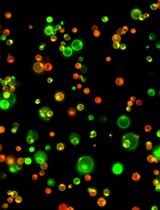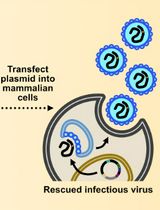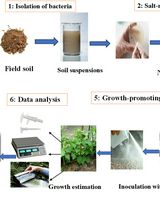- EN - English
- CN - 中文
Rice Black-streaked Dwarf Virus Preparation and Infection on Rice
水稻黑条矮缩病病毒的制备及其对水稻的感染
发布: 2017年12月20日第7卷第24期 DOI: 10.21769/BioProtoc.2651 浏览次数: 9490
评审: Feng LiXianbing Wang Anonymous reviewer(s)
Abstract
Rice black-streaked dwarf virus (RBSDV), a member of genus Fijivirus in the family Reoviridae, infects rice, maize, barley and wheat, and can seriously affect crop yields. RBSDV is transmitted by the small brown planthopper (Laodelphax striatellus, SBPH) in a persistent manner. RBSDV has 10 linear dsRNA genomic segments, making it difficult to construct infectious clones for functional studies in plants. Here we describe a method for inoculating and maintaining RBSDV on rice in a greenhouse for use in laboratory research. The protocol uses SBPHs mass reared in the laboratory. We also describe in detail the propagation of a healthy planthopper population, the preparation of plant material, RBSDV inoculation and the evaluation of the rice after inoculation.
Keywords: Rice black-streaked dwarf virus (水稻黑条矮缩病毒)Background
Rice black-streaked dwarf virus (RBSDV), a recognized member of the second group within the genus Fijivirus, family Reoviridae, seriously affects the production of rice and maize in East Asia (Shikata and Kitagawa, 1977; Zhang et al., 2001a). RBSDV is propagatively transmitted to rice, maize, barley and wheat by the small brown planthopper (Laodelphax striatellus, SBPH) in a persistent manner (Shikata and Kitagawa, 1977). SBPH can acquire RBSDV from fresh or frozen infected rice leaves and transmit it to healthy plants (Shikata and Kitagawa, 1977; Li et al., 2010). Once SBPH has acquired the virus, the virus can multiply in the insect vector and can be transmitted to host plants throughout the life of the insect. However, SBPH cannot transmit the virus transovarially (Boccardo and Milne, 1984). RBSDV has icosahedral, double-layered particles about 70-75 nm in diameter and 10 linear genomic segments of double-stranded RNA (dsRNA), ranging in size from approximately 1.8 to 4.5 kb (Marzachi et al., 1995; Zhang et al., 2001b). Our previous studies have shown the complexity of the interaction between RBSDV and host plants (Sun et al., 2015; He et al., 2017). Unfortunately, the numerous genomic segments make it difficult to construct infectious cDNA clones for reverse genetics studies. To facilitate the investigation of the interaction between RBSDV and its host plants, we describe a simple and efficient method for maintaining RBSDV infection in a greenhouse, including the propagation of the healthy planthopper population, preparation of rice plants, RBSDV inoculations and finally the evaluation of the rice disease symptom after inoculation.
Materials and Reagents
- Filter paper (Sangon Biotech, catalog number: F503311 )
- Fine soil
- Gauze and rubber band
- RNase-free tube (Thermo Fisher Scientific, InvitrogenTM, catalog number: AM12400 )
- RNase-free tip of pipettes (Sangon Biotech, catalog number: F611216 )
- Brush
- Washing bottle (Sangon Biotech, catalog number: F505001-001 )
- Pooter
- Black cloth
- Toothpick
- Fresh leaves (collected from 30-day-old rice)
- RNA extraction reagent
- Trizol reagent kit (Thermo Fisher Scientific, InvitrogenTM, catalog number: 15596018 )
- Chloroform (ShangHai LingFeng Chemical Reagent, catalog number: 1519021)
- 75% ethanol (Singpharm Chemical Chemical Reagent, catalog number: 10009257 )
- RNase-free double distilled H2O
- Trizol reagent kit (Thermo Fisher Scientific, InvitrogenTM, catalog number: 15596018 )
- Reverse transcription kit (Vazyme Biotech, catalog number: R223-01 , stored at -20 °C)
- Sterilized beads (Sangon Biotech, catalog number: B529319-0025 )
- TAE buffer (Sangon Biotech, catalog number: B548101-0500 )
- Agarose (YEASEN, catalog number: 10208ES60 )
- DNA maker 2,000 bp (Takara Bio, catalog number: 3427A )
- Ethidium bromide (Sangon Biotech, catalog number: A600195 )
- Anti-P10
- Horseradish peroxidase-labeled goat antimouse immunoglobulin G (YEASEN, catalog number: 33201ES60 )
- TMB color-substrate solution (Sangon Biotech, catalog number: C510025-005 )
- Sodium carbonate (Na2CO3)
- Sodium bicarbonate (NaHCO3)
- Sodium chloride (NaCl)
- Potassium chloride (KCl)
- Potassium phosphate monobasic (KH2PO4)
- Sodium phosphate dibasic dodecahydrate (Na2HPO4·12H2O)
- 5% skimmed milk powder (Sangon Biotech, catalog number: A600669 )
- 4-Chloro-1-naphthol
- 30% H2O2
- Fertilizer solution (containing 5% carbamide)
- Carbonate coating solution (see Recipes)
- 10x phosphate-buffered saline (PBS) (see Recipes)
- PBS-T (see Recipes)
- Blocking solution (see Recipes)
- TMB color-substrate solution (see Recipes)
Equipment
- 1 L beakers (Sangon Biotech, catalog number: F606544-0001 )
- PCR machine (Thermo Fisher Scientific, Applied BiosystemsTM, model: VeritiTM 96-Well Thermal Cycler )
- Pipettes
- Glass bottle with blue cap (Sangon Biotech, catalog number: F505041 )
- Microwave oven (Sangon Biotech, catalog number: G003408-0001 )
- Electrophoresis tank (Sangon Biotech, catalog number: G500310-0001 )
- Gel imaging system
- Eppendorf centrifuge (Thermo Fisher Scientific, for use at room temperature and 4 °C)
- Micro vacuum concentrator (Gene Company Limited)
- Automatic sample grinding machine (Shanghai Jingxin Industrial Development, model: Tissuelyser-96 )
Software
- Gel imaging software
Procedure
文章信息
版权信息
© 2017 The Authors; exclusive licensee Bio-protocol LLC.
如何引用
Sun, Z., Zhang, H., Xie, K., Tan, X., Zhang, H. and Chen, J. (2017). Rice Black-streaked Dwarf Virus Preparation and Infection on Rice. Bio-protocol 7(24): e2651. DOI: 10.21769/BioProtoc.2651.
分类
微生物学 > 微生物-宿主相互作用 > 病毒
植物科学 > 植物免疫 > 宿主-细菌相互作用
您对这篇实验方法有问题吗?
在此处发布您的问题,我们将邀请本文作者来回答。同时,我们会将您的问题发布到Bio-protocol Exchange,以便寻求社区成员的帮助。
Share
Bluesky
X
Copy link













